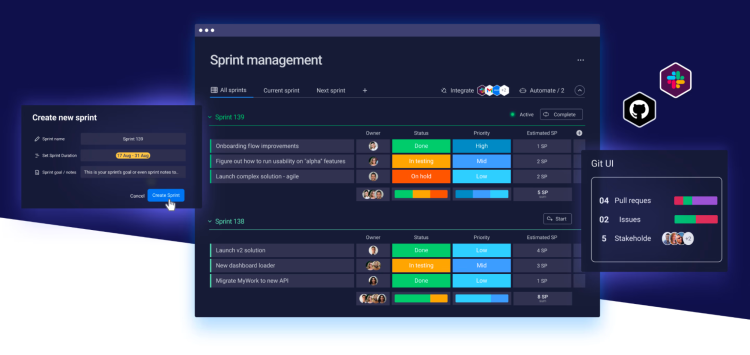
One such prominent platform, Monday.com, has gained significant traction as a work operating system, facilitating seamless collaboration and task management. However, several noteworthy options have emerged for those seeking alternatives or exploring different avenues to optimize their workflows. This article will look at the 8 best alternatives for Monday.com, each offering unique features and capabilities to streamline product management and team collaboration.
Whether you're a seasoned product manager or just starting on this exciting journey, this comprehensive exploration will help you discover the ideal alternative that aligns with your specific requirements and enhances your productivity.
TL;DR
All products mentioned in this article have clear strengths and can serve as part of a product management ecosystem. A modern product management tool must cover outcome-focused roadmaps, strong support in product discovery, easy user adoption, and seamless scalability for growing teams. According to our evaluation, airfocus is best suited to cover this full set of capabilities a modern product manager needs.
What is Monday, and why look for an alternative?
Monday.com was founded by Roy Mann, Eran Zinman, and Eran Yahav in 2012. Roy Mann, an experienced entrepreneur, serves as the CEO of the company. Eran Zinman, who previously co-founded Conduit (later renamed to Como), acts as the company's CTO. Eran Yahav, a seasoned software engineer, joined them as a co-founder and Head of Product.
The vision behind Monday.com was to create a platform that simplifies and enhances collaboration and project management for teams of all sizes and industries. The founders recognized the challenges faced by teams in staying organized, communicating effectively, and managing projects efficiently. They aimed to develop a tool that would address these pain points and provide a visual and intuitive platform for teams to collaborate, plan, and track their work.
With a focus on simplicity and flexibility, Monday.com sought to offer a work operating system that could be customized to fit various workflows and processes. The creators aimed to empower teams to work more efficiently, streamline their operations, and ultimately achieve greater productivity and success.
While Monday.com has gained popularity as a reliable work operating system, there are several reasons why someone might seek alternatives.
One tool cannot really do it all
Monday.com is a highly effective project management tool, but it faced limitations when it comes to scaling for larger product organizations.
In larger product organizations, there are typically multiple teams and departments involved, including product management, engineering, design, marketing, and more. Coordinating and aligning the efforts of these diverse teams can be challenging. While Monday.com provides collaboration features, it may not offer the level of complexity and sophistication needed to manage cross-functional collaboration at scale. Larger organizations often require more advanced features like extensive permissions, role-based access control, and complex workflow configurations to ensure smooth coordination across teams.
By their own admission, product management isn’t even one of the main use cases they cater to. While they do support some areas of focus such as roadmaps, these do not currently provide extensive capabilities to achieve proper outcomes.
Defining Monday.com competitors
When it came to looking at Monday.com competitors, we looked at answering the following:
How does it help with roadmapping and sharing roadmaps?
How does it help with discovery?
How does it help with prioritization?
How does it help with scaling teams?
How does it help with involving other team members?
What is their pricing like?
Why these questions?
Product management is about more than just creating roadmaps.
As product managers, we engage in negotiation, prioritization, communication, and collaboration with diverse teams to find optimal solutions for our customers. To achieve success, we require a platform that comprehensively understands and supports our workflows and processes.
Keeping this in perspective, we conducted thorough research by examining various online sources and reviews to evaluate our competitors. As a result, we have selected the top five authoritative sources to conduct a comprehensive analysis:
We used these sources to find the closest Monday.com alternatives and compared them with one another.
Here are your top 8 alternatives:
aha!
airfocus
Asana
Jira
Productboard
ProdPad
PPM Express
Let’s get right into it!
Aha! vs. Monday.com
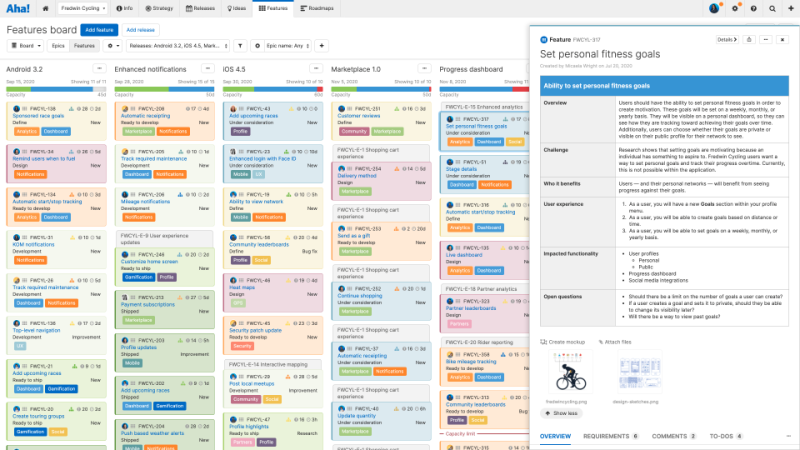
In their own words: “Anything is possible with the world's #1 product development software
Founded in 2013, Aha! was one of the first available product tools. Right from the start, it recognized that product managers require more than just roadmaps, thus broadening its services to encompass idea and feedback management. Currently, Aha!’s main focus is on large enterprises with a project-centric approach, delivering comprehensive solutions for both product and project management.
Founded in: 2013
Based in: United States
Employees on LinkedIn: 300
Funding: bootstrapped
Website: www.aha.io
How does it help with roadmapping and sharing roadmaps?
However, it's crucial to highlight that their roadmap methodology is predominantly based on timelines and Gantt charts. If you're a product manager looking to implement improved PM strategies, like outcome-oriented or theme-focused roadmaps, you might find that these options aren't really catered to in Aha!'s platform. Nonetheless, they do provide the functionality to represent goals and objectives visually, although these are all set against a delivery schedule. This places you in a project operational funnel, as opposed to a product-based one.
How does it help with discovery?
Aha! has a feedback portal where you can engage with your customers so you can gain more insights. The platform is built around a forum and voting system, which can prove challenging due to the inevitable occurrence of the Pareto Principle (where 20% of the most vocal individuals contribute 80% of the feedback.)
Should you somehow manage to sidestep this issue, establishing an internal process isn’t possible, given all feedback remains on the portal. Consequently, it's difficult to implement an in-house feedback management system for your team, utilizing feedback as part of the evidence required for making decisions and gaining a comprehensive understanding of issues.
How does it help with prioritization?
Aha! offers considerable flexibility in adopting various prioritization techniques; however, as a project-centric tool, it connects objectives to timelines and features instead of problems and outcomes. It tends to rely heavily on a specific framework rather than allowing you to make decisions based on evidence beyond the algorithm's required inputs. In other words, if you're looking for a tool to make decisions on your behalf, it might be the right tool for you. (Of course, I’m being sarcastic - please learn to make your own decisions and not rely on tools to do it for you!)
How does it help with scaling teams?
Aha! is quite adaptable, offering customizable fields and workflows that can be tailored for your team. It also provides comprehensive reporting tools to facilitate cross-functional collaboration and higher-level reporting.
How does it help with involving other team members?
Aha! includes a range of products: Roadmaps, Create, Ideas, Develop, and Academy. While these tools aim to support cross-functional teams, they can be cumbersome and their usability and UI are known to be confusing and challenging. The subpar user experience makes it difficult for teams to adopt.
What is their pricing like?
Aha! offers four plans for "Roadmaps" and two for "Ideas." "Roadmaps" starts at $59 per user per month, billed annually, and goes up to $149. "Ideas" costs either $39 per user per month, billed annually, or $59. To cover all your product management activities, you'll need both products.
Additional features come at an extra cost.
Pros and Cons
Pros:
Enhanced backlog management
Ability to create custom fields
Advanced tracking and reporting
Crowdsourcing and engagement with customers via portal
Cons:
Not outcome-based roadmapping
Project-based focus offering only timelines
Complicated UX/UI
Feature management is through voting, not problem-solving
Rating
G2: 4.3 out of 5
Capterra: 4.7 out of 5
airfocus vs. Monday.com

In their own words: “A platform built for the new way of doing product management”
airfocus is a relatively new contender in the product management world, but it has quickly demonstrated a keen understanding of practical product challenges and crafted a tool that evolves with expanding and scaling teams. With a unique approach to flexibility, modularity, and customization, it is designed to adjust to your work style.
The tool offers product strategy, discovery, roadmaps, and insights management, making it an excellent supplement to any development tool your team currently uses.
Founded in: 2017
Based in: Germany
Employees on LinkedIn: 60
Funding: $10M
Website: www.airfocus.com
How does it help with roadmapping and sharing roadmaps?
airfocus allows the creation of both individual and portfolio roadmaps, which can be shared through custom links or via a portal.
To help with a quick onboarding, the platform provides a range of templates, including ones for roadmaps, backlog, and feedback management.
These templates and workspaces are fully customizable, letting you set views, fields, and user permissions as needed. This flexibility enables visualization and comprehension of data in various ways, catering to different mental models.
How does it help with discovery?
airfocus supports discovery from both workflow and insights perspectives.
The platform places a significant emphasis on customer feedback, underscored by its user portal for direct user engagement. As feedback rolls in, you can internally manage it via custom workflows, enabling you to connect customer insights to your backlog and roadmap.
This adaptability provides you with complete control over feedback management and keeps your team attuned to user requirements.
How does it help with prioritization?
airfocus provides the most adaptable prioritization configurations among all available product platforms. Every workspace can be tailored to your requirements, enabling you to easily implement any prioritization framework you prefer. Prepopulated templates are available for a quicker start, and each framework includes an algorithm that calculates a custom score. This score can be used to visualize how items stack up against one another in a convenient comparison chart, indicating quick wins, strategic items, and potential time sinks.
The platform also features a Priority Poker tool, facilitating team alignment around opportunity priority. This tool enables a session where team members independently score opportunities, followed by a discussion on the most viable way forward, creating inclusivity and teamwork in your process.
How does it help with scaling teams?
airfocus is a modular platform, built specifically to evolve and adapt with your team. It allows you to design your own workspaces, each with its own views, workflows, fields, and integrations that align with your working style.
The team behind airfocus recognizes that no two teams operate in the same way. While they provide useful guidance through their templates, tooltips, videos, and various educational content, they also allow you the freedom to set up the platform in a way that best suits your needs.
How does it help with involving other team members?
airfocus' user-friendly interface ensures that your team can easily engage and collaborate. Besides onboarding your team, you can also utilize forms, portals, and integrations to collaborate with cross-functional team members, reducing any potential resistance to platform adoption across your organization.
The platform's most popular integrations include tools such as Intercom, Jira, and Asana, enabling you to establish a dynamic system across multiple teams.
What is their pricing like?
airfocus provides four pricing plans for their product. Pricing is based on paid seats, while also offering free viewer access. The lowest tier is $19 per user per month, billed annually. The next tier is $69. The two higher tiers are custom priced and billed annually.
Pros and Cons
Pros:
Seamless integrations with development tools like Jira, Trello, and AzureDevops
Ability to create and share roadmaps
A portfolio view of multiple roadmaps
Customizable fields and views
Custom prioritization frameworks and priority poker feature
Customer portal and insights app
Delightful UI, simple setup
Cons:
Getting accustomed to the platform's modularity might take some time
Rating
G2: 4.4 out of 5
Capterra: 4.5 out of 5
Asana vs. Monday.com
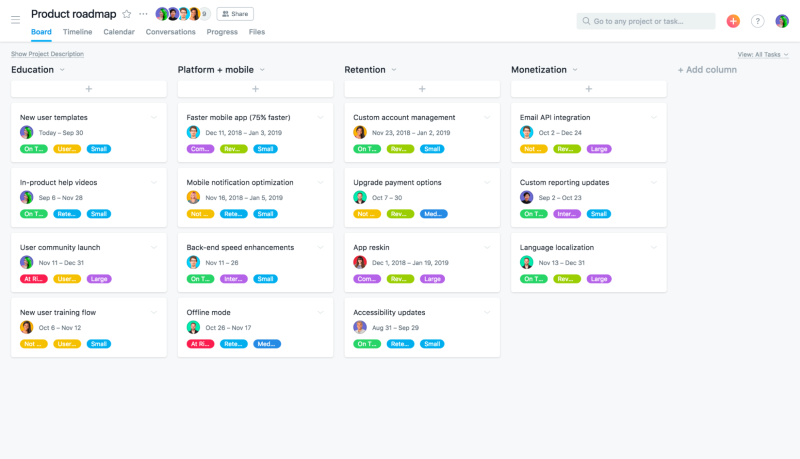
In their own words: “Align teams and drive revenue with a single platform.�”
Asana has emerged as one of the most recognized development and task management tools in recent times. The platform has broadened its capabilities to cater to diverse teams that need efficient ways of tracking tasks and project outcomes.
Founded in: 2008
Based in: United States
Employees on LinkedIn: 2500
Funding: $453.2M
Website: www.asana.com
How does it help with roadmapping and sharing roadmaps?
As a task-management tool, it doesn't fully address the requirements of product managers beyond the use of timelines. Although it is an excellent tool for managing projects, it lacks features such as outcome-based roadmaps, objectives, backlog, and feedback management.
That said, it could serve as a valuable addition to any other product management tool you are using.
How does it help with discovery?
Asana isn't ideally designed to manage feedback, insights, or research. Its primary focus is task management, making it challenging to establish a discovery process with it.
How does it help with prioritization?
Asana provides predefined labels of high, medium, and low, offering a straightforward way of handling priority. While you have the option to create custom labels, it would be challenging to develop a framework with an algorithm since these are just inputs and fields.
How does it help with scaling teams?
Asana excels in terms of scalability and team expansion - its workspaces, flexibility, and customizability make it relatively easy to adopt and adapt to growing teams.
How does it help with involving other team members?
Asana's team has invested significantly in its UX/UI design. The user interface is genuinely delightful, and you should experience minimal friction with your team. After all, we all need to manage our projects!
What is their pricing like?
Asana offers three pricing tiers per user, billed annually: free, $10.99, and $24.99.
Pros and cons
Pros:
Easy UX/UI
Interconnected apps and workflows
A variety of integrations to choose from
Cons:
It’s a task-management tool, not a product tool
No space for feedback or insights management
No ability to create product roadmaps beyond a timeline view
Rating
G2: 4.3 out of 5
Capterra: 4.5 out of 5
Jira vs. Monday.com
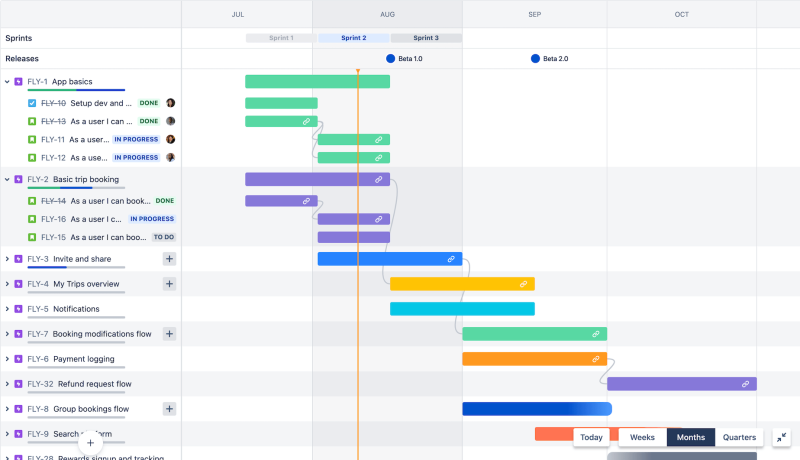
In their own words: “The #1 software development tool used by agile teams"
Jira is a part of the Atlassian suite of products, a platform primarily designed for software development teams. Its suite brings together support, operations, and project teams while offering over 3000 integrations, prioritizing cross-tool collaboration.
Founded in: 2002
Based in: Australia
Employees on LinkedIn: 15.300
Funding: $210M (Secondary market) + $462M(IPO)
Website: www.jira.com
*Data for Atlassian, Jira’s parent company
How does it help with roadmapping and sharing roadmaps?
Unless you opt for the Premium or Enterprise plans, generating external versions of your roadmap with Jira can be challenging. The extra expense could strain your budget, and without it, you'll need to find innovative ways to share your roadmap with team members, board members, and customers.
However, the platform has made significant progress in incorporating objectives and initiatives, leaning more towards product management and improved work methods.
How does it help with discovery?
It's crucial to remember that a roadmap isn't an isolated document; it needs input from your product backlog and customer feedback, and that's where Jira lacks. There's no mechanism to monitor customer feedback with an internal feedback management system, making discovery and research within the tool difficult. You could potentially create a separate board or create links to Confluence documents, but like other all-in-one tools, it would require your IT manager's approval and setup of your integration, causing some inconvenience.
How does it help with prioritization?
To set up prioritization frameworks, custom fields are required, and you'll need someone with the necessary permissions (like your IT manager). This could delay quick setup and make long-term maintenance more difficult.
How does it help with scaling teams?
The entire Atlassian suite was developed with scalability in mind. However, this comes with a somewhat complex administrative process. The vast number of user permissions in Atlassian almost makes it impossible to modify the platform without the assistance of your IT manager, making the process of onboarding and offboarding individuals less than smooth.
How does it help with involving other team members?
Jira's extensive user permissions can be both a boon and a bane. While it's great to involve other team members and maintain security, assigning those permissions often requires an IT manager. The tool's UI is known for its complexity, which may pose an adoption challenge to business-facing teams.
For a product team to function effectively, cross-functional collaboration is crucial. But if others resist adopting your workspace, teamwork becomes more difficult.
What is their pricing like?
Jira offers four pricing plans: free, $7.50, $14.50 per user per month (irrespective of annual or monthly payment). Finally, there's an enterprise tier, available only with annual billing from 801 users at $10.70 per user per month.
Pros and cons
Pros:
Dedicated tool for software development teams
Offers integrations with over 3000 apps
Customizable boards, reports, timelines, and views
Extensive user permissions for enhanced security
Cons:
It is not a product management tool
Time-consuming administration process
Interface and configuration can be confusing and complex
Rating
G2: 4.2 out of 5
Capterra: 4.4 out of 5
Productboard vs. Monday.com
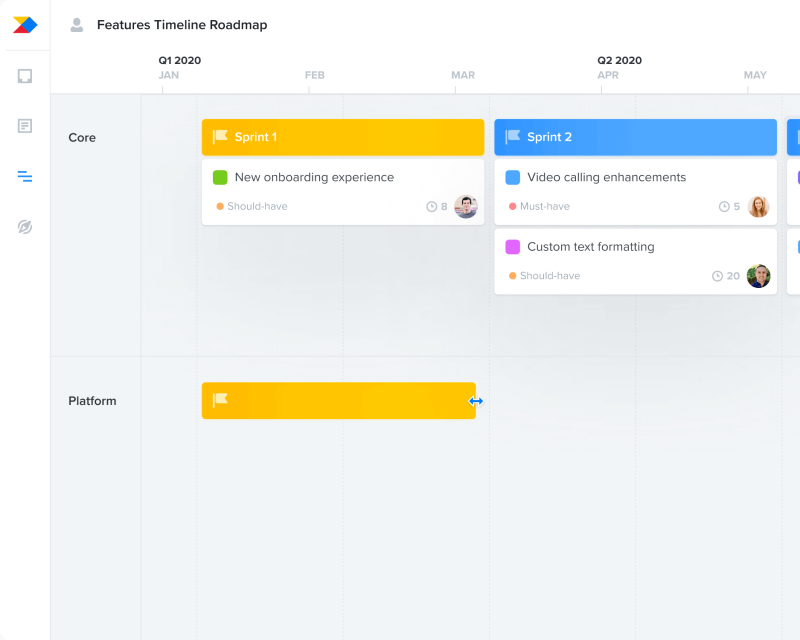
In their own words: “Productboard helps product teams understand what customers need, prioritize what to build next, and align everyone around the roadmap.”
Productboard has gained a lot of popularity in recent years, offering a focus on roadmapping and customer centricity. With offices located in San Francisco, Prague, and Vancouver, Productboard has grown into a global organization in recent years.
Founded in: 2014
Based in: San Francisco, California
Employees on LinkedIn: 500
Funding: $125M Series D
Website: www.productboard.com
How does it help with roadmapping and sharing roadmaps?
Productboard's approach to product management includes working with timeline roadmaps, offering templates like "release roadmap" and "timeline roadmap." They provide the ability to create a "now, next, later" roadmap, but it is predominantly centered around releases rather than outcomes. The platform bypasses the concept of initiatives, placing features directly on the roadmap, which could potentially lead to a build trap.Their roadmaps are readily shareable through links and a customized portal.
How does it help with discovery?
Productboard features a user portal for gathering feedback around items in discovery or general feedback. However, everything in their backlog is labeled as a "feature," and the concepts of ideas or opportunities are overlooked, which could be a red flag when attempting to run discovery and experimentation.
How does it help with prioritization?
While Productboard allows you to set up any prioritization framework you prefer, you have no control over how the algorithms are calculated. The absence of initiatives on the roadmap level means that other factors associated with the initiative (like objectives, vision, theme) are entirely disregarded - everything happens at the individual feature level.
How does it help with scaling teams?
Productboard does support multiple workspaces, but they aren't connected. The alternative would be to manage multiple products from a single space, assuming your entire team is comfortable with the same set of views, fields, and workflows. However, if you want to provide your teams with a single source of truth while allowing for greater flexibility, Productboard may not scale effectively in that direction.
If you choose the route of multiple workspaces, the lack of interconnection will prevent any form of cross-team collaboration or the ability to roll up multiple roadmaps into a single portfolio for your entire team.
How does it help with involving other team members?
Productboard's design is aesthetically pleasing, but its usability falls short. It often requires a lot of clicking around to locate items, and the user interface can be confusing to work with.
What is their pricing like?
Productboard offers four different pricing plans, billed per user per month. The plans start at $20, continue with $80, with the top two plans available upon request.
Pros and cons
Pros:
Focus on customer feedback and insights
Public portal for customer engagement
Ability to share roadmaps
Cons:
Mixed messaging around roadmaps and product approach - is it project or product based?
Price can be quite steep
No focus on discovery, experimentation, or outcomes
Rating
G2: 4.3 out of 5
Capterra: 4.7 out of 5
ProdPad vs. Monday.com
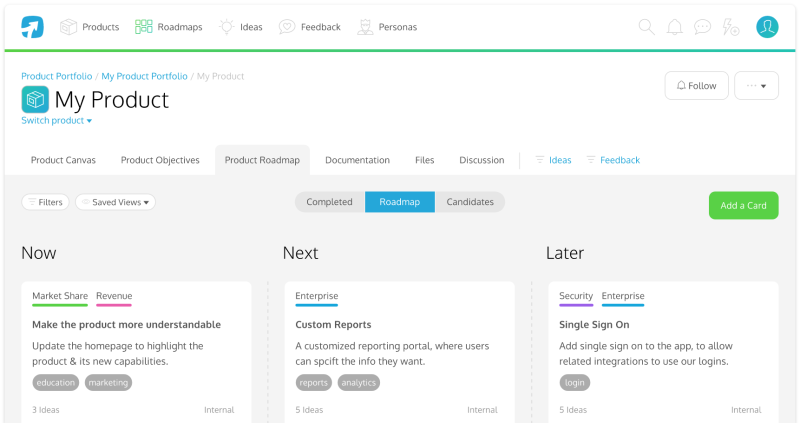
In their own words: “Clear the chaos and unite teams with a single source of truth to create outstanding products."
ProdPad is one of the rare tools in the product industry that is focused on outcomes. It provides access to best practices from the outset, making it an excellent tool for any product team looking to transition to an outcome and discovery-centric approach.
Founded in: 2012
Based in: UK
Employees on LinkedIn: 20
Funding: Bootstrapped
Website: www.prodpad.com
How does it help with roadmapping and sharing roadmaps?
The team behind ProdPad developed the original Now, Next, Later roadmap, making them experts in roadmapping best practices. Their roadmaps are intuitive and engaging, with extensive customization options for sharing. All roadmaps can be shared via a PDF, URL, or embed code.
You can also create a portfolio view for a comprehensive understanding of your product.
However, it has some limitations, such as the lack of dependency tracking across products.
How does it help with discovery?
ProdPad provides a portal and widget for gathering customer feedback and setting up custom workflows. However, it lacks extensive customization options for your team. While you can adjust workflows, you cannot set up multiple workflows per team—everyone has to work within the same workspace and follow the same process. Customization on the widget and portal are somewhat limited and are created and shared independently from the roadmap. There are also constraints when creating a custom feedback workflow, as they impose their own approach.
How does it help with prioritization?
ProdPad offers a basic impact vs effort prioritization scale, which can be visualized as a Fibonacci sequence, 1-10 scale, or as t-shirt sizes. However, they do not provide customization of prioritization frameworks, so you are limited to the options they offer. If you're comfortable with this approach, you'll be able to compare items on their priority chart, which helps visualize key strategic items and potential time-wasters.
How does it help with scaling teams?
Every team or organization operates differently. The challenges arise when you want your entire organization to work from a single source of truth. ProdPad requires everyone to work within a single workspace, with no customization over fields, workflows, or processes, meaning everyone has to work in the same way. Workspaces are available with an Enterprise account, but they are not connected (essentially separate accounts, which you can switch between).
How does it help with involving other team members?
ProdPad has not made significant strides in involving individuals outside the product team. Although it's user-friendly, it lacks integrations with third-party commercial apps like Intercom or Zendesk, making you depend on tools like Zapier for integrations. They do offer a 'reviewer' role which might be useful for your team, but all features are available to all roles and permissions simultaneously, making it difficult to guide your team towards the right area.
What is their pricing like?
ProdPad’s pricing is based on modules and power-ups. Their base modules are all $20 per editor/per month for access to roadmaps, ideas, and feedback. Their power-ups are all $10 per editor per month and include features like portfolios, OKRs, publishing, and portal access.
Pros and cons
Pros:
They’re the creators of the modern product roadmap
Ability to create a portfolio view
Has access to feedback and portals
Cons:
No customization of fields or views
No customization of workflows or processes for backlog or feedback
No customization of priority frameworks
No scalability for larger teams
Rating
G2: 4.2 / 5
Capterra: 3.8 / 5
PPMExpress vs. Monday.com
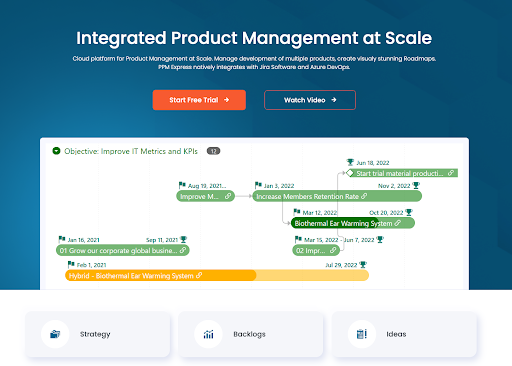
In their own words: “Save Hundreds of Hours With integrated Project Portfolio Management Software.”
PPMExpress was founded in Canada in 2018 with the original strategy to develop software products and implement PPM on the Microsoft PPM Platform. It has since branched out from being exclusively a Microsoft tool and expanded its project management software into other domains, including product.
Founded in: 2018
Based in: Canada
Employees on LinkedIn: 17
Funding: bootstrapped + undisclosed initial funding
Website: https://ppm.express/
How does it help with roadmapping and sharing roadmaps?
With a project-first approach, PPMExpress only provides timelines and Gantt charts. These can be exported as CSV or PNG files, but there is no option for external sharing through a URL or portal.
How does it help with discovery?
PPMExpress includes an idea dashboard for idea management. Here, you can propose ideas and include details such as risk and capacity. These ideas can also be linked to strategic objectives. However, the concept of customer feedback is completely absent, meaning you'd have to manage feedback separately or forego a customer-focused approach in your discovery process.
How does it help with prioritization?
PPMExpress seems to misunderstand the application of prioritization frameworks. Although it offers popular frameworks such as ICE, RICE, and WSJF, they are only available at the roadmap level. Individual ideas can be scored through a "decision matrix," but users have no control over what to include or exclude from this matrix.
How does it help with scaling teams?
PPMExpress provides three basic permission levels across the product, which can be accessed through regular logins, Microsoft365, or a Google SSO integration. While inviting users is straightforward, encouraging usage may be a different story due to the platform's focus on project portfolio management and lack of customer feedback management. This is likely to deter business-facing teams from using it.
However, they do offer several integrations with tools like Jira, Azure DevOps, and even Monday.com.
How does it help with involving other team members?
While it's easy to invite users, fostering cross-team collaboration could prove challenging as there are no integrations with business-facing tools. This could lead to alignment issues within the organization.
What is their pricing like?
PPMExpress offers three pricing tiers. Both Product Management and Portfolio Management have annual and monthly options starting at $25 per user per month, and an Enterprise plan is also available.
Pros and cons
Pros:
Offers integrations with Jira and Azure Devops
Extensive integration with Microsoft tools
Cons:
Is a project management tool
Difficult UI
No feedback management
All roadmaps are timeline-based
Rating
G2: 4.6 out of 5
Capterra: 4.3 out of 5
Trello vs Monday.com
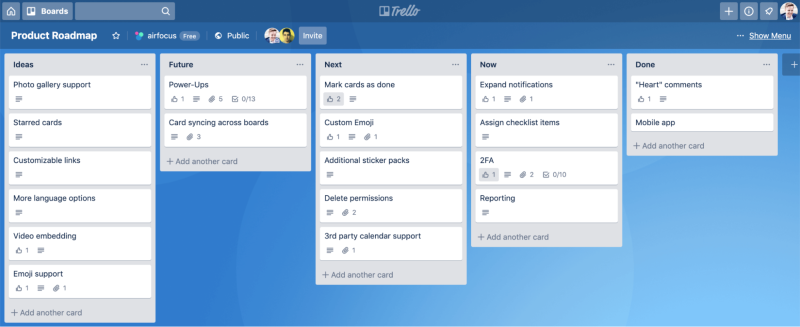
In their words: “Keep everything in the same place—even if your team isn’t.”
Trello, one of the most well known and loved task-management tools, was acquired by Atlassian not too long ago. Now part of Atlassian's ecosystem, it has helped expand their suite of task management and software development tools.
Founded in: 2010
Based in: United States
Employees on LinkedIn: 100
Funding: $10M Series A + acquired by Atlassian for $425M
Website: www.trello.com
How does it help with roadmapping and sharing roadmaps?
Trello's main feature is its boards, which can be customized with unique fields, labels, and integrations, known as "power-ups". However, it's important to remember that having boards doesn't necessarily mean you have a roadmap. Trello excels in setting up Kanban workflows, but using it to create a comprehensive roadmap can be challenging, especially when trying to establish a product hierarchy across multiple boards.
How does it help with discovery?
Trello allows you to set up a custom board focused on discovery, and another one for development tasks. However, if you're looking to manage customer feedback, you'll need yet another board. Juggling multiple boards that aren't well interconnected can quickly become unmanageable, and this setup doesn't scale effectively in the long term.
How does it help with prioritization?
Trello's custom fields and labels can help prioritize items, but it can be difficult to consider items across different boards. Trello is excellent at unblocking productivity and providing focus, but this focus tends to be linear and makes it challenging to consider various product hierarchy levels.
How does it help with scaling teams?
In terms of software development and task management, Trello does offer the capability to create workspaces for individual and team needs. You can establish team boards, private boards, and even share cards between boards.
How does it help with involving other team members?
Trello is widely used and liked by individuals both within and outside of product teams, which should minimize friction in adoption.
What is their pricing like?
Trello's pricing begins at $0, with subsequent tiers costing $5, $10, and $17.50 per user per month, billed annually.
Pros and Cons
Pros:
Easy to use and get started
Integrations with hundreds of other tools
High customization of fields
Cons:
It is not a product management tool
Its focus is on task management
Several limitations unless you’re on the Enterprise plan
Rating
G2: 4.4 out of 5
Capterra: 4.5 out of 5
Conclusion
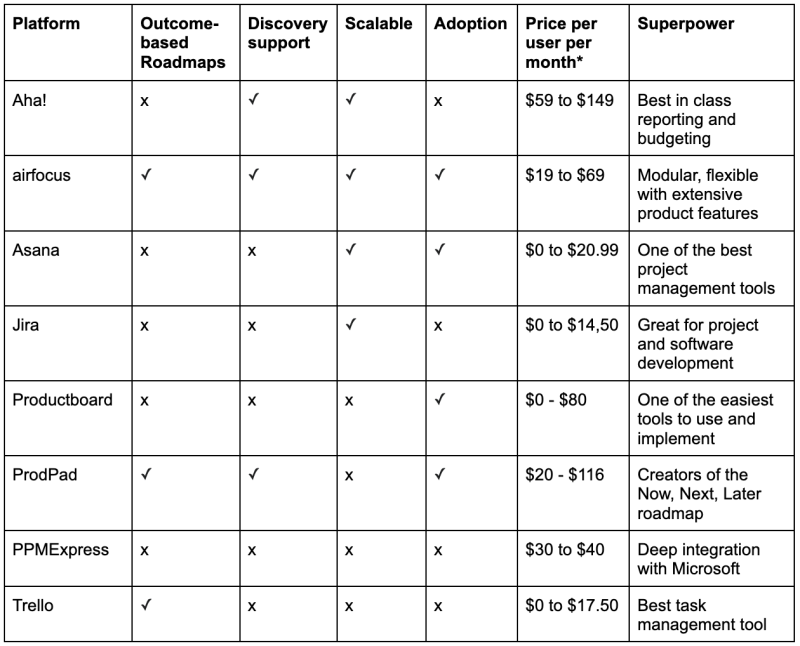
* public prices only, billed annually. All companies offer custom enterprise prices on demand.
Monday.com’s work OS is a fantastic addition to anyone looking to expand and improve workflows, but it is not currently designed to help product management teams at scale. Their focus has been on other business functions, and while they have touched upon certain product areas, they still have a way to go before we can consider it a full product management tool. We do wish them the best of luck!
If you want to learn more about how to apply better product management practices, feel free to check out our academy guide on just that.

Andrea Saez

Read also






Experience the new way of doing product management

Experience the new way of doing product management



